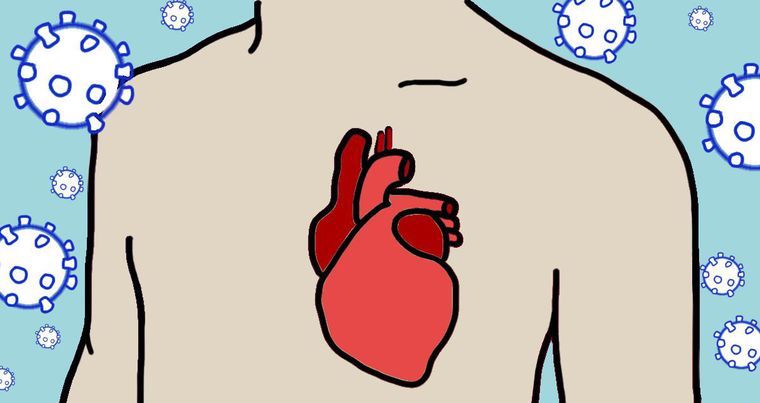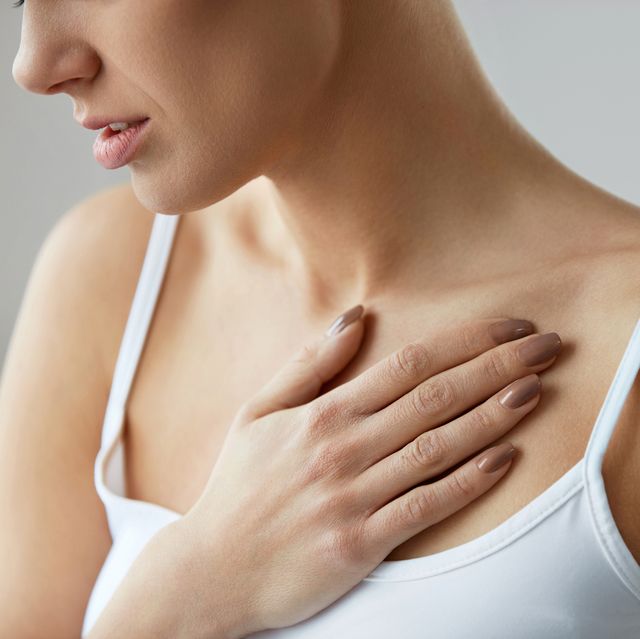Everyone has felt pain around their chest or a sort of tightness in the area, and many people have panicked about it, not knowing the exact reason for this sensation. They would wonder: Is it a cardiac arrest? Is it an anxiety attack? Is it a lung problem? However now, a new question arises concerning feeling pain in the chest; it’s COVID-19. Although this virus has many symptoms on the human body, chest pain seems to be the symptom that scared people the most, as they strictly link it to the heart and consider the worst-case scenarios.
WHAT IS CHEST PAIN?
Chest pain is a discomfort that leads to pressure or a squeezing feeling in the center of the chest, and this sensation could be due to many reasons. It could be a pain caused by coronary heart disease, or it could be caused by problems in your lungs, or from a panic disorder caused by psychological issues, and recently it could be due to the COVID-19 virus.

CHEST PAIN AND COVID-19
Is chest burning a sign of COVID-19?
COVID-19 is a respiratory disease that started in late 2019, because of a virus called SARS-CoV-2. People who suffer from COVID-19 develop illnesses that could be mild or severe. The older the patient, the higher the risk of developing high-risk symptoms like chest pains.
The pandemic that occurred because of the COVID virus has led to chest pains caused by many reasons. Chest pain and tightness are direct symptoms of psychological stress and anxiety that people have been feeling more than ever during this crisis. But how do we know if this chest pain is a symptom of the virus itself, or is a symptom of the virus’s side effects? The only way to know is by seeking a doctor’s professional help and care, or taking a test to determine whether the person is infected with the virus.
Even though chest pain does not play a big role in the main COVID-19 symptoms, it could occur in some cases. However, it will not be the only symptom felt, meaning it will be accompanied by COVID’s usual symptoms like a runny nose, coughing, and a fever, to name a few. And in this case, the pain is not because of a panic attack, it is just because of the virus. Nevertheless, getting checked by a healthcare provider is always for the best.
As we said, chest pains in COVID-19 are not very common, since research has found that only 2% of people who were ill with COVID-19 reported chest pains as their only symptom, but 28% of adults reported feeling chest pain alongside their other symptoms. It is less rare with kids, where only 10% of children felt this type of pain. But even though it is rare, it must be taken more seriously and drastically than all other symptoms, since people who died from COVID-19 reported feeling chest pain approximately three times more than people who survived the virus.

SYMPTOMS OF CHEST PAIN DURING COVID-19
Symptoms of chest pain are not always direct and obvious. Sometimes, symptoms that show before the high-intensity pain might occur to help you uncover the reason behind this pain in your chest. These symptoms vary from back pain, shoulder pain, arm pain, or jaw pain. To add, confusion, trouble breathing, and a loss of consciousness might occur before the chest pain. And finally, rapid breathing or a rapid heart rate might also be a direct symptom.
CAUSES OF CHEST PAIN DURING COVID-19
COVID-19, also called coronavirus, is a virus that attacks the lungs mainly, and it might affect the heart. This fact itself can cause chest pains and burning sensations in the chest and lungs area.
What causes this chest pain?
While one suffers from the COVID-19 virus, two main sources might cause chest pain. They can be categorized into heart damages and lung inflammations.
The coronavirus leads to damages and inflammation after entering your cells and harming them. These cells, called ACE2, are mainly found in the lungs, heart, and gastrointestinal tract.
Heart Damage:
Cytokine Storm Syndrome is the phenomenon where the molecules released by your immune system because of the coronavirus, called inflammatory cytokines, cause damage to heart cells. Meaning not only does the coronavirus lead to heart damages, but also your immune system, trying to defend itself, might lead to this outcome.
Plus, people who suffer from lung dysfunctions and low oxygen levels can also suffer from heart damage while contracting the coronavirus.
Finally, people with previous heart injury and a history of coronary heart diseases or high blood pressure have shown to have a 60% higher possibility rate of suffering from heart damage during COVID. This means that people with a history of cardiovascular diseases should watch out more for heart damages during this pandemic.
Lung Inflammation:
While suffering from COVID-19, a release of inflammatory molecules occurs. These molecules spread into the pleural space – the area between layers of the sac that surrounds each of the lungs – and lead to lung inflammation. Lung inflammation in its turn triggers pain receptors, leading to chest pain and burning.
To add, COVID-19 has been shown to cause pneumonia. Pneumonia is an extreme type of lung infection and causes a high amount of chest pain
CHEST PAIN AND LONG COVID
Long COVID is a term used to describe the after-effects of COVID-19. It is defined by any symptoms and signs that continue to develop after acute COVID-19.
As we mentioned, chest pain is one of the symptoms of this virus, but some people start to experience chest burnings and pain a few weeks after they test negative from the coronavirus, or experience aches that started during their infection and are still lasting.
The feeling of severe chest pain felt while suffering from long Covid usually does not come alone. It is accompanied by vomiting, nausea, sweating, shortness of breath, and a loss of consciousness. This type of pain is sudden, severe, and does not go away easily.
There are many types of pain felt after getting infected with COVID-19:
The first one is a feeling of pain and soreness in a specific area in the chest and that feels worse after touching it and after specific movements such as turning the chest or stretching the body. This type is called myalgia or muscle pain and could be because of COVID or any other severe infection.
The other type is non-specific chest pain. It is known to be dull but sharp and happens in short bursts suddenly and quickly.

HOW LONG DOES IT TAKE TO RECOVER FROM LONG COVID?
Being a new virus that has begun only two years ago means that not all answers can be found. The long side effects and how much they last vary from one person to the other. This fact is not unique to the coronavirus; all viral illnesses have lasting side effects with an unknown end to them.
But research and statistics have shown that patients who particularly suffered from this virus, and who needed hospitalization and treatments, might take up to five months or more to heal completely, with some extreme cases that last up to 12 months or more.
An important note is that not all chest pains are because of COVID-19. A person may have suffered from coronavirus and started feeling chest pains a couple of weeks after because of a completely different problem. This is why checking up on your health and getting medical advice is always important when feeling a new type of pain.
HOW TO PLAN FOR CHEST PAINS DURING COVID-19?
One must always plan for any type of pain and medical emergency to be able to postpone or even prevent it.
Some ways to plan are:
- Keeping a big supply of medications in the house, especially in these circumstances, where sometimes a sudden lockdown occurs.
- Having regular check-ups with the doctor to manage heart attack risk factors like high cholesterol, diabetes, obesity, and smoking.
- Leading a healthier lifestyle, eating better, exercising, decreasing smoking and alcohol.
TREATMENTS
The treatments of chest pain will differ according to the cause. Even if it is because of the coronavirus, the pain could be either because of heart damage or lung inflammation, as previously mentioned. Each has its kind of treatment, but it might involve pain relievers to ease the discomfort either way.
COVID-19 CHEST PAIN TREATMENT
This type of chest pain caused by the coronavirus is usually resolved by over-the-counter medications or by additional treatments if the patient were ill enough to require hospitalization.
These treatments are done through rest, nitroglycerin, or both. This pain is caused by a lack of blood supply, meaning an increase in the heart’s blood supply will relieve the patient from the pain. This is what nitroglycerin achieves.
Another very important coping mechanism used during this time that has shown a lot of help is doing breathing exercises. They decrease anxiety and stress, and they play an important role in the COVID-19 recovery process. This leads to the patient feeling much more relaxed and at ease.
If you or anyone you know has severe pain in your shoulder, please contact our pain management specialists at Specialty Care Clinics.
Call (469) 545-9983 to book an telehealth appointment for an at home check-up.
